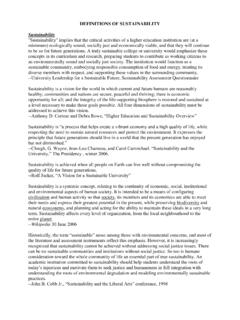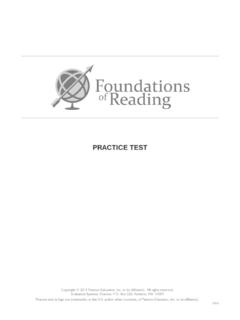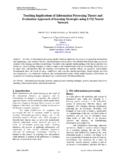Transcription of Foundations of Reading Study Guide
1 Foundations of Reading Study Guide Created and Compiled by: Jennifer Arenson Yaeger Literacy Coach and Educational Consultant Web Site: Updated September 2018 Jennifer Arenson Yaeger Foundations of Reading Study Guide 2018 2 Table of Contents OVERVIEW OF THE TEST AND RESOURCES FOR PREPARATION 3 Foundations OF Reading DEVELOPMENT (35% OF THE TEST) 9 Section 0001 Understand phonological and Phonemic awareness : 10 Section 0002: Understand Concepts of Print & the Alphabetic Principle: 17 Section 0003: Understand the Role of Phonics in Promoting Reading Development 21 Section 0004: Understand Word Analysis skills and Strategies 33 DEVELOPMENT OF Reading COMPREHENSION (27% OF THE TEST) 37 Section 0005: Understand Vocabulary Development: 38 Section 0006: Understand How to Apply Reading Comprehension skills and Strategies to Imaginative/Literary Texts 44 Section 0007: Understand How to Apply Reading Comprehension skills and Strategies to Informational/Expository Texts 54 Reading ASSESSMENT AND INSTRUCTION (18% OF THE TEST) 58 Section 0008.
2 Understand Formal and Informal Methods for Assessing Reading Development: 59 Section 0009: Understand Multiple Approaches to Reading Instruction 68 TEACHING Reading TO ENGLISH LANGUAGE LEARNERS 69 STAGES OF Reading DEVELOPMENT 71 INTEGRATION OF KNOWLEDGE AND UNDERSTANDING (20% OF THE TEST) 76 Section 0010: Prepare an organized, developed analysis on a topic related to one or more of the following: Foundations of Reading development; development of Reading comprehension; Reading assessment and instruction. 77 OPEN RESPONSE QUESTIONS AND MTEL OVERVIEW CHARTS 78 GLOSSARY 92 Overview of the Test and Resources for Preparation Jennifer Arenson Yaeger Foundations of Reading Study Guide 2018 4 Key Websites Jennifer Yaeger s Web Site o This site includes the MTEL Foundations of Reading Practice Test, MTEL Foundations of Reading Multiple Choice Analysis, MTEL Test Information Booklet with sample questions, Put Reading First and many other helpful links: MTEL Website o The MTEL Foundations of Reading Practice Test.
3 O The MTEL Foundations of Reading MTEL Practice Test Analysis: Put Reading First Other Recommended Texts/ Study Guides o Boosalis, Chris Nicholas (2004). Beating them All! Boston: MA. Pearson. o Kinzer, & Leu, (2011) Phonics, Phonemic awareness , and Word Analysis for Teachers: An Interactive Tutorial, 9/e. Boston, MA: Allyn and Bacon. Reading Rockets This site includes useful and informative articles on a variety of Reading related topics. In particular, below is a list of web addresses to suggested articles included in this Study Guide : Types of Phonics Instruction and Instructional Methods: What Does Research Tell Us About Teaching Reading to English Language Learners?
4 : Jennifer Arenson Yaeger Foundations of Reading Study Guide 2018 5 Test Overview Chart: Foundations of Reading (PreK-6) (90) Subareas Approximate Number of Multiple-Choice Items Number of Open-Response Items I. Foundations of Reading Development 43-45 II. Development of Reading Comprehension 33-35 III. Reading Assessment and Instruction 21-23 IV. Integration of Knowledge and Understanding 2 The Foundations of Reading test is designed to assess the candidate s knowledge of Reading /language arts required for the Massachusetts Early Childhood, Elementary, and Moderate Disabilities licenses.
5 This subject matter knowledge is delineated in the Massachusetts Department of Education s Regulations for Educator Licensure and Preparation Program Approval (7/2001), 603 CMR Subject Matter Knowledge Requirements for Teachers. The Foundations of Reading test assesses the candidate s proficiency and depth of understanding of the subject of Reading and writing development based on the requirement that the candidate has participated in seminars or courses that address the teaching of Reading . Candidates are typically nearing completion of or have completed their undergraduate work when they take the test.
6 The multiple-choice items on the test cover the subareas as indicated in the chart above. The open-response items may relate to topics covered in any of the subareas and will typically require breadth of understanding of the field and the ability to relate concepts from different aspects of the field. Responses to the open-response items are expected to be appropriate and accurate in the application of subject matter knowledge, to provide high quality and relevant supporting evidence, and to demonstrate a soundness of argument and understanding of the field.
7 Official Massachusetts Tests for Educator Licensure (MTEL) test objectives and preparation materials appear on the MTEL Website at Copyright 2013 Pearson Education, Inc. or its affiliate(s). All rights reserved. Evaluation Systems, Pearson, Box 226, Amherst, MA 01004. Jennifer Arenson Yaeger Foundations of Reading Study Guide 2018 6 Massachusetts Tests for Educator Licensure TM FIELD 90: Foundations OF Reading TEST OBJECTIVES Multiple-Choice Range of Objectives Approximate Test Weight I. Foundations of Reading Development 01-04 35% II.
8 Development of Reading Comprehension 05-07 27% III. Reading Assessment and Instruction 08-09 18% 80% Open-Response IV. Integration of Knowledge and Understanding 10 20% Official Massachusetts Tests for Educator Licensure (MTEL) test objectives and preparation materials appear on the MTEL Website at Copyright 2013 Pearson Education, Inc. or its affiliate(s). All rights reserved. Evaluation Systems, Pearson, Box 226, Amherst, MA 01004. Jennifer Arenson Yaeger Foundations of Reading Study Guide 2018 7 Charts that Support General Concepts on the MTEL Explicit Instruction Implicit Instruction Most important first step in a sequence of instruction For extension and practice; reinforcement of a previously taught skill Teacher models, demonstrates; often direct instruction Learning may be placed in an authentic context, where many skills and understandings are developed simultaneously ( shared Reading ).
9 Overt objective; measurable May feel less clear what would be assessed Principal could walk in the door and without seeing lesson plan would be able to identify purpose Purpose may be unclear to an outside observer (or even participant) Focused May not appear focused Multiple Choice: How to approach certain types of When Multiple Choice Questions Relate to Word Identification When Multiple Choice Questions Relate to Vocabulary and Comprehension Think: Back to Basics Think: Which activity would help develop independent readers and critical thinkers?
10 Traditional approach; may feel rote Focus is on deep, not superficial understanding Teacher-directed; very focused Active learning instead of passive Explicit, systematic, sequential phonics instruction is of primary importance (use of syntax, semantics, context clues should be considered back-up plans ) Not random assignments, but focused ones Jennifer Arenson Yaeger Foundations of Reading Study Guide 2018 8 Reading Development and Identification of Gaps Foundations of Reading Development What is often the missing part of the equation??? Comprehension and Fluency Oral Language phonological awareness (specifically phonemic awareness ) Emergent Literacy Concepts about Print Letter Identification Alphabetic Principle (letters and letter combinations represent sounds) Word Identification.




